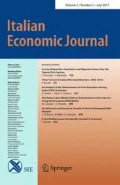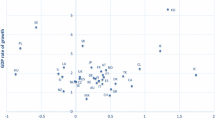Abstract
The paper is aimed to re-evaluate the relationship between tax structure and economic growth relying on linear and non-linear panel cointegrated VAR models. The asymmetric impact of tax changes on growth is estimated adapting the threshold cointegration methodology proposed by Hansen and Byeongseon (J Econom 110:293–318, 2002) to the panel framework. The tests indicate that the weak exogeneity and linearity hypotheses are not supported by data. Thus, the empirical results obtained by previous literature in a linear single-equation framework must be interpreted with caution. We find that recurrent taxes on immovable property seem to be the least harmful for the growth, while we do not found compelling evidence favouring consumption taxes over income taxes. Therefore, our results do not fully support the policy prescriptions proposed by many international organizations aimed at shifting the tax burden from income to consumption and property. Moreover, these findings are robust and significant when the tax burden is above the threshold value of around 30%, which is the case for the tax revenue to GDP ratio for the most of European countries in the sample. Policy conclusions are also discussed.
Similar content being viewed by others
Notes
This condition implies that any change in a tax structure indicator is compensated by an equivalent change in another indicator to keep the total tax revenue as a share of GDP unchanged, other things being equal.
It is worth noting that there are also empirical studies that in the analysis of the growth effects of the tax structure do not adopt the hypothesis of tax revenue neutrality (see Kneller et al. 1999; Lee and Gordon 2005). In this case, the influence of the tax structure on the economic growth becomes less evident.
The MG estimator may be sensitive to the presence of country-specific estimates with extreme values. To avoid this problem, we use the strategy proposed by Bond et al. (2010) that allows to obtain an outlier-robust MG estimator.
For an extensive discussion of threshold regression models, we refer to Tong (1990).
See Di Sanzo and Pérez-Alonso (2011) for details about Monte Carlo and bootstrap simulations in threshold models.
We also checked if the empirical results depend from the choice of non-fiscal growth determinants. Using different sets of non-fiscal variables (such as trade openness indicators etc.) we found similar estimates, thus we settle on this parsimonious specification of the model.
Country and estimation period is dictated by data availability only and more precisely, for Australia, Greece, Japan, Netherlands and Switzerland the full sample period is 1970–2011, while for Portugal the sample reduced to 1989–2012.
References
Agell J, Ohlsson H, Thoursie P (2006) Growth effects of government expenditure and taxation in rich countries: a comment. Eur Econ Rev 50:211–218
Andrews DWK, Ploberger W (1994) Optimal tests when a nuisance parameter is present only under the alternative. Econometrica 62:1383–1414
Arachi G, Bucci V, Casarico A (2015) Tax structure and macroeconomic performance. Int Tax Public Financ 22:635–662
Arnold J (2008) Do tax structures affect aggregate economic growth? Empirical evidence from a panel of OECD countries. OECD Working Paper No. 643
Arnold J, Brys B, Heady C, Johansson A, Schwellnus C, Vartia L (2011) Tax policy for economic recovery and growth. Econ J 121:59–80
Auerbach AJ, Gorodnichenko Y (2012) Measuring the output responses to fiscal policy. Am Econ J 4(2):1–27
Barro RJ (1989) Economic growth in a cross section of countries. NBER Working Paper No. 3120
Barro RJ (1990) Government spending in a simple model of endogenous growth. J Polit Econ 98:103–117
Barro RJ (1991) Economic growth in a cross section of countries. Q J Econ 106:407–443
Baum A, Poplawski-Ribeiro M, Weber A (2012) Fiscal Multipliers and the state of the economy. IMF Working Paper No. 286
Bond S, Leblebicioglu A, Schiantarelli F (2010) Capital accumulation and growth: a new look at the empirical evidence. J Appl Econom 25:1073–1099
Chan KS (1990) Testing for threshold autoregression. Ann Stat 18:1886–1894
Chudik A, Pesaran MH (2015) Common correlated effects estimation of heterogeneous dynamic panel data models with weakly exogenous regressors. J Econom 188:393–420
Davies RB (1977) Hypothesis testing when a nuisance parameter is present only under the alternative. Biometrika 64:247–254
Davies RB (1987) Hypothesis testing when a nuisance parameter is present only under the alternative. Biometrika 74:33–43
Di Sanzo S, Pérez-Alonso A (2011) Unemployment and hysteresis: a nonlinear unobserved components approach. Stud Nonlinear Dyn Econom 15:24–50
Easterly W, Rebelo S (1993) Fiscal policy and economic growth: an empirical investigation. J Monet Econ 32:417–458
Engle RF, Granger CWJ (1987) Cointegration and error correction: representation, estimation and testing. Econometrica 55:251–276
European Commission (2013) Taxation trends in the European Union. Publications Office of the European Union
Fölster S, Henrekson M (2001) Growth effects of government expenditure and taxation in rich countries. Eur Econ Rev 45:1501–1520
Gemmel N, Kneller R, Sanz I (2014) The growth effects of the tax rates in the OECD. Can J Econ 47(4):1217
Hadri K (2000) Testing for stationarity in heterogeneous panel data. Econom J 3:148–161
Hansen BE (1996) Inference when a nuisance parameter is not identified under the null hypothesis. Econometrica 64:413–30
Hansen BE, Byeongseon S (2002) Testing for two-regime threshold cointegration in vector error correction models. J Econom 110:293–318
Hiemstra C, Jones JD (1994) Testing for linear and nonlinear Granger causality in the stock price-volume relation. J Financ 49:1639–1664
Im KS, Pesaran MH, Shin Y (2003) Testing for unit roots in heterogeneous panels. J Econom 115:53–74
Im KS, Lee J, Tieslau M (2005) Panel LM unit-root tests with level shifts. Oxf Bull Econ Stat 67:393–419
Institute for Fiscal Studies (2010) Dimension of tax design: the Mirless review. Oxford University Press, Oxford
Jaimovich N, Rebelo S (2015) Non-linear effects of taxation on growth. J Polit Econ (forthcoming)
Johansen S (1988) Statistical analysis of cointegrating vectors. J Econ Dyn Control 12:231–254
Johansen S (1991) Estimation and hypothesis testing of cointegration vectors in Gaussian vector autoregressive models. Econometrica 59:1551–80
Johansen S (1995) Likelihood-based inference in cointegrated vector autoregressive models. Oxford University Press, Oxford
Johansen S, Mosconi R, Nelsen B (2000) Cointegration analysis in the presence of structural breaks in the deterministic trend. Econom J 3:216–249
Jones L, Manuelli R, Rossi P (1993) Optimal taxation in models of endogenous growth. J Polit Econ 101:485–519
Juselius K (2006) The cointegrated VAR model: methodology and applications. Oxford University Press, Oxford
King R, Rebelo S (1990) Public policy and economic growth: developing neoclassical implications. J Polit Econ 98:S126–S150
Kneller R, Bleaney MF, Gemmell N (1999) Fiscal policy and growth: evidence from OECD countries. J Public Econ 74:171–190
Lee Y, Gordon RH (2005) Tax structure and economic growth. J Public Econ 89:1027–1043
Maddala GS, Wu S (1999) A comparative study of unit root tests with panel data and a new simple test. Oxf Bull Econ Stat 61:631–652
Mendoza E, Milesi-Ferretti G, Asea P (1997) On the effectiveness of tax policy in altering long-run growth: Harberger’s superneutrality conjecture. J Public Econ 66:99–126
OECD (2008) Tax and economic growth. Economics Department Working Paper No. 620
OECD (2010) Going for growth. OECD Publishing, Paris
Pedroni P (2000) Fully-modified OLS for heterogeneous cointegrated panels and the case of purchasing power parity. Adv Econom 15:93–130
Pedroni P (2004) Panel cointegration; asymptotic and finite sample properties of pooled time series tests, with an application to the PPP hypothesis. Econom Theory 20:575–625
Pedroni P (2007) Social capital, barriers to production and capital shares: implications for the importance of parameter heterogeneity from a nonstationary panel approach. J Appl Econom 22:429–451
Perotti R (1999) Fiscal policy in good times and bad. Q J Econ 114:1399–1436
Pesaran MH, Smith RP (1995) Estimating long-run relationships from dynamic heterogeneous panels. J Econom 68:79–113
Pesaran MH, Shin Y, Smith R (1999) Pooled mean group estimation of dynamic heterogeneous panels. J Am Stat Assoc 94:621–634
Tong H (1990) Nonlinear time series: a dynamical system approach. Oxford University Press, Oxford
Xing J (2012) Tax structure and growth: how robust is the empirical evidence? Econ Lett 117:379–382
Author information
Authors and Affiliations
Corresponding author
Rights and permissions
About this article
Cite this article
Di Sanzo, S., Bella, M. & Graziano, G. Tax Structure and Economic Growth: A Panel Cointegrated VAR Analysis. Ital Econ J 3, 239–253 (2017). https://doi.org/10.1007/s40797-017-0056-0
Received:
Accepted:
Published:
Issue Date:
DOI: https://doi.org/10.1007/s40797-017-0056-0




